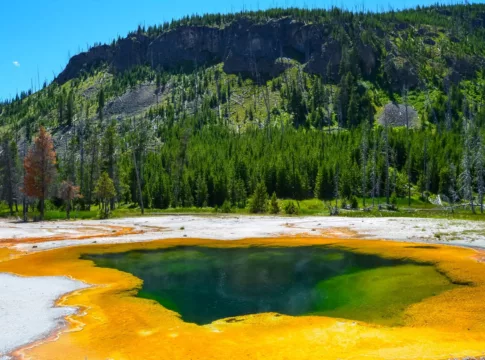A new study using the James Webb Space Telescope (JWST) has observed a surprisingly mature galaxy, JADES-GS+53.18343−27.79097, formed within the first 700 million years after the Big Bang. This galaxy is about 100 times smaller than the Milky Way but shows advanced characteristics for its early age, featuring a dense star cluster at its center and a less dense outer region. Notably, star formation is accelerating in the galaxy’s outskirts, indicating ongoing development.
‘Inside-out’ growth of a galaxy observed in the early Universe


A magma cap beneath Yellowstone National Park
Scientists have identified a magma cap beneath Yellowstone National Park, located about 2.4 miles (3.8 km) below the surface. This cap acts as a pressure-regulating layer, preventing magma from rising too quickly and reducing the likelihood of an eruption. The cap consists of molten silicate materials, supercritical water, and porous rock, which trap heat and gas within the volcanic system. Researchers used seismic imaging and advanced modeling to study its structure.

Novel material can convert CO₂ into fuel
Researchers have developed a stable metalcone thin film for converting atmospheric CO₂ into methanol, a liquid fuel. By mildly annealing tincone at 250°C, they improved its stability in aqueous solutions while enhancing its electrochemical properties. This breakthrough overcomes a major challenge in using Metalcones for carbon reduction applications. The next step involves integrating this engineered material into real-world systems to assess its efficiency in CO₂ conversion. This innovation paves the way for more sustainable fuel production and advances in photoelectrochemical applications.

Martian Clues to Life? NASA Rover Finds Large Organic Molecules on...
NASA’s Curiosity rover has detected the largest organic molecules ever found on Mars—decane, undecane, and dodecane. These hydrocarbons, believed to be fragments of fatty acids, suggest that Mars' organic chemistry may have been more complex than previously thought. The findings support the possibility that ancient Mars had the right conditions for life. Scientists emphasize the need to bring samples back to Earth for deeper analysis, as Curiosity's instruments may not detect even larger, more complex molecules that could further reveal Mars’ potential for past life.

A cost-effective catalyst to revolutionize hydrogen production
Researchers from the Tokyo University of Science developed a new catalyst called bis(diimino)palladium coordination nanosheets (PdDI). These low-cost palladium-based nanosheets perform as well as platinum in producing hydrogen. Created using a simple synthesis process with minimal precious metals, the nanosheets reduce metal usage and lower hydrogen production costs.